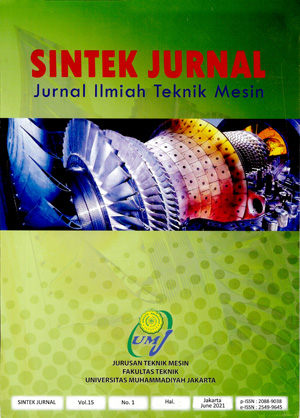MEASUREMENT OF EFFICIENCY UTILIZATION OF OIL PALM SOLID WASTE TO REDUCE FUEL IMPORT LEVELS IN INDONESIA
Main Article Content
Abstract
Article Details
- Articles published in SINTEK JURNAL are licensed under a Creative Commons Attribution-ShareAlike 4.0 International license. You are free to copy, transform, or redistribute articles for any lawful purpose in any medium, provided you give appropriate credit to the original author(s) and SINTEK JURNAL, link to the license, indicate if changes were made, and redistribute any derivative work under the same license.
- Copyright on articles is retained by the respective author(s), without restrictions. A non-exclusive license is granted to SINTEK JURNAL to publish the article and identify itself as its original publisher, along with the commercial right to include the article in a hardcopy issue for sale to libraries and individuals.
- By publishing in SINTEK JURNAL, authors grant any third party the right to use their article to the extent provided by the Creative Commons Attribution-ShareAlike 4.0 International license.
References
Wati, E., et al. (2019). ‘From Rubber to Oil Palm’: Livelihood Structural Transformation of Local and Transmigrant Farmer Households in Minangkabau. Sodality: Jurnal Sosiologi Pedesaan, 7(2), 86-94.
Wibowo, L.R., et al., Penyelesaian tenurial perkebunan kelapa sawit di kawasan hutan untuk kepastian investasi dan keadilan. Vol. 247. 2019: CIFOR.
Industry, G. (2011). Ministry of Industry. Direktorat Jenderal Industri Kecil dan Menengah [Directorate General of Small and Medium Industries].
Hidayatno, A., et al. (2015). System dynamics sustainability model of palm-oil based biodiesel production chain in Indonesia. International Journal of Engineering and Technology (IJET), 15(06), 20-26.
Murtiningrum, M. and A. Firdaus. (2016). Perkembangan biodiesel di indonesia tinjauan atas kondisi saat ini, teknologi produksi & analisis prospektif. Penelitian dan Aplikasi Sistem dan Teknik Industri, 9(1), 182836.
Hasibuan, S. and H. Thaheer. (2017). Life Cycle Impact Assessment Produksi Biodiesel Sawit Untuk Mendukung Keberlanjutan Hilirisasi Industri Sawit Indonesia. Prosiding SENIATI, C47. 1-7.
Adler, S., et al. (2016). Getting rid of performance ratings: Genius or folly? A debate. Industrial and Organizational Psychology, 9(2), 219-252.
Lam, M.K., et al. (2009). Malaysian palm oil: Surviving the food versus fuel dispute for a sustainable future. Renewable and Sustainable Energy Reviews, 13(6-7), 1456-1464.
Kuss, V.V., et al. (2015). Potential of biodiesel production from palm oil at Brazilian Amazon. Renewable and Sustainable Energy Reviews, 50, 1013-1020.
Susanto, J.P., A.D. Santoso, and N. Suwedi. (2017). Perhitungan Potensi Limbah Padat Kelapa Sawit untuk Sumber Energi Terbaharukan dengan Metode LCA. Jurnal Teknologi Lingkungan, 18(2), 165-172.
Horbar, J.D., et al. (2002). Trends in mortality and morbidity for very low birth weight infants, 1991–1999. Pediatrics, 110(1), 143-151.


